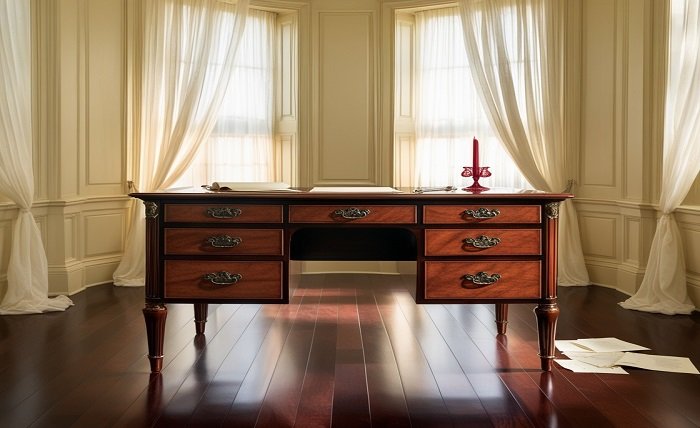Overview
A writing desk is one of the most important pieces of furniture when it comes to designing the perfect workspace at home or in the office. The cornerstone of your productivity is a writing desk, which facilitates thought organization, stores essential materials, and offers a cozy workspace. However, with so many alternatives available, selecting the ideal workstation can be a difficult undertaking. A writing desk with drawers is one of the most useful options for people who want to improve their productivity and appearance among the wide variety of styles and designs available.
What Is a Writing Desk with Drawers?
One kind of desk made for writing, typing, and other office activities is a writing desk with drawers. It differs from other desks since it has built-in drawers for storage. The size, style, and functionality of these drawers can vary, but they usually keep documents, office supplies, and other necessities accessible and organized. Drawers improve the desk’s utility by enabling it to be used for purposes other than writing or working.
Benefits of a Writing Desk with Drawers
There are several advantages to a writing desk with drawers that might change the way you operate. The following are some of the strongest arguments in favor of including one in your study or home office:
Improved Organization: Pens, paper, notebooks, and other supplies can be kept organized and conveniently accessible with the use of drawers.
Expanded Workspace: By keeping your desk surface clutter-free, built-in storage allows you to work with greater space.
Better Aesthetics: A neat and orderly desk frequently has a more polished and eye-catching appearance.
Various Styles of Drawered Writing Desks
There are numerous styles of writing desk with drawers to meet a range of tastes and requirements. These are a few of the most prevalent kinds:
Conventional Writing Desks: Usually constructed of wood, these desks are classic. They may have a central drawer for writing instruments in addition to drawers on one or both sides.
Contemporary Desks for Writing: Modern writing tables are sleeker, more minimalist, and frequently feature integrated or concealed drawers to keep a simple, streamlined appearance.
Executive desks are bigger: workstations made for professionals that want additional room. For organizing, they usually feature several drawers and sections.
Selecting the Appropriate Size for Your Area
Think about the desk’s size in relation to the area you have available before investing in a writing desk with drawers. A desk that is too big can overcrowd your workplace or room, but you also need enough drawer space and surface area to meet your demands.
Measure Your Space: To begin, take measurements of the space where the desk will be placed. Make sure to leave room for chairs and other furniture as well as for people to move around the desk.
Examine the Surface Area of the Desk: Consider how much room you’ll need for writing, utilizing a computer, and other activities. If you want a lot of space for projects, you might need a larger desk.
The components and design of writing desks with drawers
The desk’s lifetime and functionality are greatly influenced by the quality of its construction and material. Typical components of writing desk with drawers include:
Wood: Because of its natural beauty and longevity, wood is a timeless option for writing desk with drawers. Desks made of solid wood are typically more costly, but they have a classic appearance and are built to last.
Metal: Metal desks provide a more contemporary and industrial look when combined with glass or wood components. These desks can nevertheless be sturdy while being lighter and generally less expensive.
Glass: Despite becoming less popular, glass desks have a sleek, modern look. They may have drawers made of wood or another material, and they frequently have metal or wooden frames.
Aesthetic and Design Considerations
A writing desk with drawers should blend well with the interior design of the space it is situated in. Think about the overall look you hope to accomplish:
Rustic: Distressed wood, antique handles, and a warm, inviting appearance are common characteristics of a writing desk with drawers in the rustic or farmhouse design.
Industrial: To produce a stylish, contemporary appearance with an urban vibe, industrial designs incorporate raw elements like wood and metal.
Mid-Century Modern: Sleek and simple, with hardwood drawers and a minimalistic style, mid-century desks are renowned for their clean lines and practical construction.
Conclusion
An elegant and useful complement to any workstation is a writing desk with drawers. The correct workstation may greatly increase your comfort and productivity, regardless matter whether you’re a professional, student, or just someone who enjoys writing or working from home. To pick a desk that suits your demands, take into account elements like size, material, design, and drawer arrangement.
FAQ
What kind of material works best for a desk with drawers for writing?
For writing tables, wood is frequently regarded as the ideal material, particularly if you want longevity and a timeless style. But if you want a more contemporary or minimalist look, glass or metal tables are fantastic.
How should the drawers on my writing desk be arranged?
To keep little objects like pens, paper clips, and sticky notes apart, use drawer organizers. To keep things organized, think about utilizing boxes, trays, or file folders for larger goods. Learn more about: lebossduturf
Can compact areas accommodate writing desks with drawers?
Indeed! In addition to offering storage space, many small writing desk with drawers are made to fit in smaller spaces. To make the most of your available space, look for desks with corner desks or shallow drawers.

